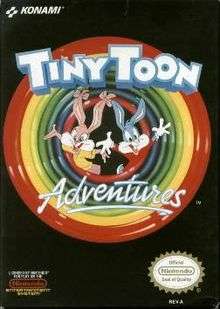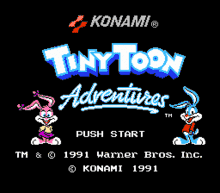Tiny Toon Adventures (video game)
| Tiny Toon Adventures | |
|---|---|
 North American cover art | |
| Developer(s) | Konami |
| Publisher(s) | Konami |
| Director(s) | Kazuyuki Yamashita |
| Composer(s) |
Jun Funahashi Masae Nakashima Satoko Minami |
| Platform(s) | Nintendo Entertainment System |
| Release | |
| Genre(s) | platformer |
| Mode(s) | Single-player |
Tiny Toon Adventures is a platform video game for the NES. It was published and developed by Konami and released in 1991. It is the first Tiny Toon Adventures-related video game to be released for any video game console device.[1]
Gameplay

The player initially controls Buster Bunny in the effort to rescue Babs Bunny from her kidnapper, Montana Max. Before each world, the player can select an alternate character that they can switch into if they find a star ball. The three alternate characters are Dizzy Devil, Furrball, and Plucky Duck. Dizzy, Furrball, and Plucky have unique abilities that Buster lacks: Plucky can briefly fly, Dizzy can destroy walls and most enemies with his spin mode, and Furrball can climb many vertical surfaces, slowly sliding down them rather than plunging down. However, Buster can jump higher than others.
There are six worlds in the game, with three levels each: The Hills, The Wetlands, The Trees, Downtown, Wackyland (unlike the rest, this world only has one level), and Montana Max's Mansion. Aiding Buster is Hamton, who will give Buster an extra lives for 30 carrots each. The second level in each world concludes with an enclosed area where the player must avoid Elmyra and exit through the door; if the player is grabbed by Elmyra, they must start the world over. The third level in each world concludes with a boss battle.
Duck Vader (a parody of Darth Vader) makes a cameo appearance as a secret boss if the number of carrots collected in any level is a multiple of eleven. If the player can defeat him without losing one life in the process, three extra lives will be gained.
Reception
| Reception | ||||||||||||
|---|---|---|---|---|---|---|---|---|---|---|---|---|
| ||||||||||||
Nintendo Power had placed the game at 19th for March 1993 of their magazine regarding Top 20 NES games at that point.[6]
Entertainment Weekly gave the game an A- and wrote that "This multilevel action game is easy enough for even small children to master, although older kids may be challenged by the higher levels. Unfortunately, the game is marred by an inexplicable lapse in design judgment: Why is it super-competent Babs Bunny who gets chased by the evil Montana Max, and why must she be rescued by the all-male trio of Hamton, Plucky Duck, and Buster? [...] Sexism aside, boys and girls alike should enjoy this game, which captures both the sassy attitude and the overstated, bug-eyed animation of the TV show."[7]
References
- ↑ "Tiny Toon Adventures (1991) NES review". MobyGames. 2013-07-29. Retrieved 2015-10-02.
- ↑ "1UP! Tiny Toon Adventures (NES)". August 7, 2009. Retrieved 12 November 2015.
- ↑ The Missing Link (December 1991). "GamePro Issue 29" (29): 38.
- ↑ Steve Merrett & Radion Automatic (November 1992). "Nintendo Magazine System Issue 3" (3): 119.
- ↑ Hamilton, Rob (22 December 2006). "Tiny Toon Adventures (NES) review". HonestGamers. Retrieved 18 December 2015.
- ↑ "Nintendo Power Issue 46" (46). March 1, 1993: 101. Retrieved November 12, 2015.
- ↑ https://ew.com/article/1992/08/07/latest-videogames-reviewed/